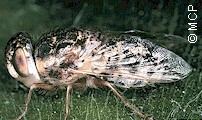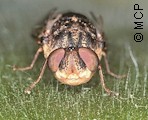Sheep nasal bot flies (Oestrus ovis) occur worldwide where sheep and goats are abundant. They attack mainly sheep, goats and deer, and very occasionally horses, cattle, dogs, and humans, but not pig or poultry. They lay eggs in the nostrils of sheep and the maggots crawl into the animals nostrils.
Prevalence and incidence are regionally very different and depend strongly on climatic and ecologic conditions. In regions with a cold winter it is a late spring and summer pest. In regions with a warm climate it can infest sheep the whole year through.

Nasal bot flies are obligate parasites, i.e. they cannot complete their life cycle without parasitizing their hosts. Within the myiases, nasal bot flies are primary myiases, i.e. they do not need a previous injury of the host to deposit their eggs on it.
The disease caused by the larvae of these flies is called oestrosis.
Are sheep infected with Oestrus ovis contagious for humans?
- NO. The reason is that the parasitic maggots that infect a particular animal cannot be transmitted to other animals directly. The eggs that develop to parasitic maggots are deposited by the adult flies preferentially on sheep and goats. For additional information read the chapter on the life cycle below.
You can find additional information in this site on the general biology of insects and on the parasitic flies.
Biology and life cycle of nasal bot flies
Adult flies are 10 to 12 mm long, with a bee-like hairy aspect, and of a light to dark grayish color. Adult flies do not feed at all and live only for 15 to 30 days, enough to mate and reproduce. Female flies are larviparous, i.e. they do not deposit eggs, but already hatched larvae.
Each female can produce up to 500 larvae, which she deposits in small batches inside the nostrils of her victim. The young larvae get into the nasal cavities where they attach using well-developed buccal and caudal hooks. Subsequently they also molt and grow in size to reach up to 30 mm length. Larvae mature and leave the nostrils in about 30 days by warm weather, or remain for up to 9 months inside the nasal cavity until the next spring, when they crawl out of the nose and drop to the ground. Mature larvae can also be expelled with a sneeze. Once on the ground they bury themselves and pupate within 24 hours. One to two months later adult flies emerge out of the pupae. Usually there are not more than 2 generations a year.
Click here to learn more about the general biology of insects.
Harm and economic loss due to nasal bot flies
Sheep and goats react strongly to the presence of female flies, which they recognize by their typical buzzing. They shake their heads, snort vigorously, press the nostrils against the ground, hide the head between the legs, try to run away, etc. This behavior disturbs normal grazing and herd management. Once the larvae get into the nasal cavity (sometimes by the dozens) sheep are significantly annoyed. Irritation of the nasal mucosa, excess mucous discharge, swelling, sneezing and difficult breathing are typical symptoms.
Altogether the result is malnutrition, weight loss, and poor condition that can significantly reduce productivity (wool, meat and milk). Deaths can happen, especially of young or otherwise weaker animals. If a few fly larvae fail to leave the nasal cavities and die inside they can cause septic sinusitis that can lead to deaths due to septicemia. Very occasionally a few larvae may reach the host's brain, which is usually fatal.
Prevention and control of nasal bot flies
 Sheep already affected by nasal bot flies can be treated with several veterinary parasiticides.
Sheep already affected by nasal bot flies can be treated with several veterinary parasiticides.
Macrocyclic lactones (e.g. ivermectin) administered as injectables or as oral drenches have an excellent curative efficacy and provide also several weeks protection against re-infestations.
Several anthelmintics are also effective against sheep nasal bot flies, e.g. closantel, nitroxinil and rafoxanide. They are available as injectables or drenches in numerous countries. For closantel protection periods of up to 8 weeks have been reported. A few organophosphates (e.g. trichlorfon) has been successfully used against established oestrosis both as a pour-ons and as an injectable.
There are also reports on effective control of established infestation using Bacillus thuringiensis administered indoors to confined sheep as an aerosol. Learn more about biological control of flies and other insects.
There are no repellents that keep theese flies away from sheep.
For the time being there are no vaccines that will protect sheep by making them immune to bots. And there are no traps for specifically catching sheep nasal bot flies.
Click here if you are interested in medicinal plants for controlling external parasites of livestock and pets.
Resistance of sheep nasal bot flies to parasiticides
So far there are no reports on resistance of sheep nasal bot flies to parasiticides.
This means that if a particular product has not achieved the expected control, it is most likely because the product is not adequate or it was not used correctly, not because sheep nasal bot flies have become resistant.
Learn more about parasite resistance and how it develops.